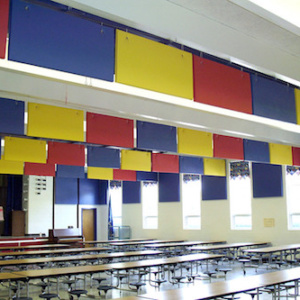Noise control, acoustics and sound privacy within educational settings are imperative. During the design process, target STC’s for walls should be discussed and mandated by the architect, but oftentimes topical acoustical treatment for larger spaces is held until after construction is complete. By treating excessive reverberation, you can achieve ideal educational acoustics without requiring after-market acoustical products. With the hard, reflective surfaces present within gymnasiums, cafeterias, and auditoriums, acoustical absorption is needed to maintain speech intelligibility and reduce reverberation.
Acoustic Design for Educational Facilities
The architects for Marchman Technical College consulted with Commercial Acoustics for their cafeteria space, where we supplied them with 100 PVC-wrapped baffles to absorb soundwaves. After installing the baffles, reverberation in the cafeteria space was significantly reduced and sound privacy was finally reestablished.
Acoustic ceiling baffles are excellent absorbing products for long, open spaces where sound can travel great distances without hitting a surface. When the surface finishes are hard and reflective, this results in excessive reverberation. High reverberance is associated with poor speech intelligibility, as people have a hard time distinguishing between the initial sound and the reflected echos. Any reverb time, RT60, over 1.5 seconds is generally too high for a speaking environment. In spaces like cafeterias and restaurants, where spills and stains make it important to use clean, and usually hard, surfaces, noise control is of paramount importance.
Listing of other Education Acoustic Projects



